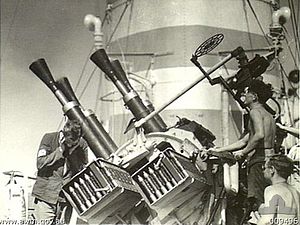
Back Vickers QF 2 pounder Mark II Bulgarian Canó naval QF de 2 lliures Catalan QF 2-Pfünder-Marinegeschütz German Cañón naval QF de 2 libras Spanish Canon de marine de 2 livres QF French Meriam laut QF 2-pounder ID Vickers-Armstrong QF 2 lb Italian ヴィッカース QF 2ポンド砲 Japanese Armata przeciwlotnicza 40 mm Mark II Polish 40-мм пушка Виккерс Мк 2 Russian
| QF 2 pdr Mark VIII ("pom-pom") | |
|---|---|
 Quadruple 2 pdr MK VIII guns on Mk.VII mounting aboard HMAS Nizam August 1941 | |
| Type | Autocannon |
| Place of origin | United Kingdom |
| Service history | |
| In service | 1917–1940s (Mk II) 1930–1940s (Mk VIII) |
| Used by | British Empire Japan Thailand Russian Empire Kingdom of Italy Netherlands |
| Wars | First World War Second World War |
| Production history | |
| Designer | Vickers Armstrongs |
| Designed | 1915 (Mk II) 1923 (Mk VIII) |
| Variants | Low-velocity (LV) & high-velocity (HV) RHI, LHI, RHO, LHO for multiple mountings Type 91 HI Shiki (Japanese) |
| Specifications (Mk.VIII HV) | |
| Mass | 850 lb (390 kg) |
| Length | 8 ft 6 in (2.59 m) |
| Shell | 40×158mmR |
| Calibre | 40 mm (1.6 in) |
| Barrels | 1, 4 or 8 |
| Rate of fire | 115 rpm |
| Muzzle velocity | new gun: 732 m/s (2,400 ft/s) worn gun: 701 m/s (2,300 ft/s)[1] |
| Effective firing range | 3,960 m (13,300 ft) A/A ceiling |
| Maximum firing range | 6,220 m (20,400 ft) at 701 m/s (2,300 ft/s)[2] |
| Feed system | 14-round steel-link belt |
| Filling weight | 71 g (2.5 oz) |
The 2-pounder gun, officially the QF 2-pounder (QF denoting "quick firing") and universally known as the pom-pom, was a 40 mm (1.6 in) British autocannon, used as an anti-aircraft gun by the Royal Navy.[note 1] The name came from the sound that the original models make when firing. This QF 2-pounder was not the same gun as the Ordnance QF 2-pounder, used by the British Army as an anti-tank gun and a tank gun, although they both fired 2 lb (0.91 kg), 40 mm (1.6 in) projectiles.
Cite error: There are <ref group=note> tags on this page, but the references will not show without a {{reflist|group=note}} template (see the help page).